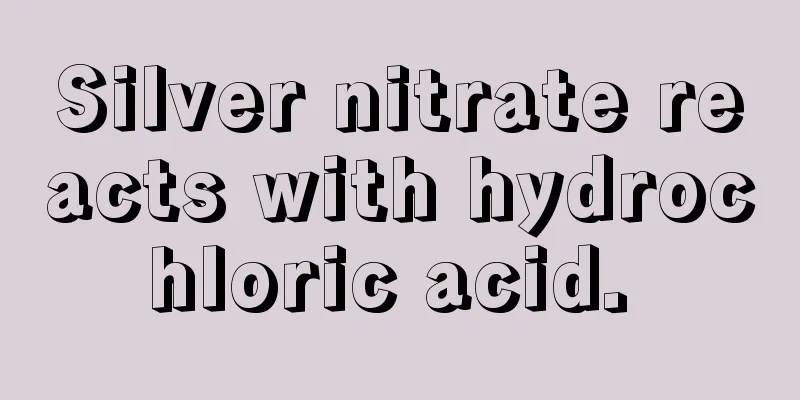Silver nitrate reacts with hydrochloric acid.

|
Most people start learning about chemistry in junior high school. Chemistry seems to open a door to the material world for us. That's when we began to understand physical and chemical reactions. From the simple reaction of hydrogen and oxygen to form water, to the later chemical valence changes and molecular structures of high arsenic. From then on, the microscopic world opened up to us. During this long learning career, we have come into contact with many chemical reactions and many things that we do not normally come into contact with. Although we don't come into contact with them often, when we mention them, we will know how they react. Today we will talk about the reaction between silver nitrate and hydrochloric acid. HCl+AgNO3=AgCl↓+HNO3 This is a very basic chemical equation, but in the exam, it is an ionic equation. Cl- + Ag+ = AgCl↓ 1. hydrochloric acid Hydrochloric acid (hydrochloric acid[1]) is an aqueous solution of hydrogen chloride (HCl)[2]. It is a monobasic inorganic strong acid with a wide range of industrial uses. Hydrochloric acid is a colorless, transparent liquid with a strong pungent odor and is highly corrosive. Concentrated hydrochloric acid (mass fraction is about 37%) is extremely volatile. Therefore, when the container containing concentrated hydrochloric acid is opened, the hydrogen chloride gas will evaporate and combine with water vapor in the air to produce small droplets of hydrochloric acid, causing acid mist to appear above the bottle mouth. Hydrochloric acid is the main component of gastric acid, which can promote food digestion and resist microbial infection. In the 16th century, Libavius formally recorded the preparation method of pure hydrochloric acid: mixing concentrated sulfuric acid and table salt and heating them[3]. Later, chemists such as Glauber, Priestley, and Davy also used hydrochloric acid in their research[4]. During the Industrial Revolution, hydrochloric acid began to be produced in large quantities. In the chemical industry, hydrochloric acid has many important applications and plays a decisive role in the quality of products. Hydrochloric acid can be used for pickling steel[5] and is also a chemical reagent required for the large-scale preparation of many inorganic and organic compounds[6][7], such as vinyl chloride, the precursor of PVC plastic. Hydrochloric acid has many other small-scale uses, such as in household cleaning, in the production of gelatin and other food additives, as a descaling agent, and in leather processing. About 20 million tons of hydrochloric acid are produced worldwide each year. On October 27, 2017, the World Health Organization's International Agency for Research on Cancer published a preliminary list of carcinogens for reference, and hydrochloric acid was on the list of Category 3 carcinogens. 2. Silver nitrate solution Characteristics Colorless, transparent large crystals or white small crystals. Odorless. The pure product does not turn black in light and air, but the presence of hydrogen sulfide or trace organic matter can promote photoreduction and turn black. It is a light yellow liquid after melting and remains white after solidification. When heated to 440°C, it decomposes into silver, nitrogen, oxygen and nitrogen oxide. It has a coagulating effect on protein. 1g is dissolved in 0.4ml water, 0.1ml boiling water, 30ml ethanol, 6.5ml boiling ethanol, and 253ml acetone. It is easily soluble in ammonia water and glycerin, and slightly soluble in ether. Aqueous and ethanol solutions react strongly with litmus, with a pH value less than 2.0. Above this pH value, it will hydrolyze to produce a brownish-brown Ag2O·nH2O precipitate. Relative density (d19) 4.352. Melting point 212℃. Boiling point 444℃ (decomposition). Oxidizing. Toxic, median lethal dose (mouse, oral) 50 mg/kg store Store in a sealed, dry place away from light. The solution is stored in a brown reagent bottle. Safety measures Store in a cool and dry place, away from fire and heat sources. Store separately from edible chemicals, reducing agents, alkalis, metal powders and flammable materials. Fire extinguishing: direct water, mist water, sand and soil. use Determination of chloride, bromide, iodide, cyanide and thiocyanate. Catalyst for the determination of manganese. plating. Manufacture of silver salts. photography. Porcelain coloring. |
<<: Aluminum hydroxide and hydrochloric acid
>>: Iron oxide reacts with hydrochloric acid
Recommend
Will pancreatic tumor recur after removal?
Pancreatic tumor is the most common tumor among m...
Tests for early diagnosis of kidney cancer
The harmfulness of kidney cancer cannot be ignore...
Does lucky bamboo absorb formaldehyde?
Some people worry that the formaldehyde content i...
How to treat gastric retention
Gastric retention is a relatively common symptom....
How to effectively treat habitual dislocation
Habitual dislocation can easily occur in some chi...
Farting while pooping
Farting is a normal physiological phenomenon in t...
Which hospital is best for osteosarcoma
Everyone is afraid of osteosarcoma, which is a li...
The harm of excessive arsenic to human body
Although we don't hear the term arsenic very ...
What are the principles of fibroid treatment
What are the principles of fibroid treatment? In ...
Can gout patients eat fish?
Gout is a common disease among middle-aged and el...
The first symptoms of breast cancer usually include breast lumps
The first symptom of breast cancer is usually a b...
Blood streaks on the face
There are many reasons for bloodshot eyes. The mo...
What is the process of atherosclerosis
Atherosclerosis is a common cardiovascular diseas...
What are the symptoms of epidermoid cyst?
Epidermoid cyst is actually also called lipochole...
Is it normal for women to have abundant pubic hair?
Whether male or female, pubic hair will grow afte...









